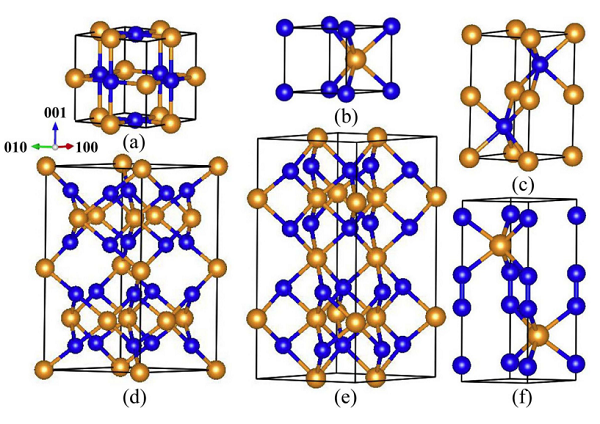Tungsten nitrides and W-N structures
Description
Tungsten nitrides represent a distinct family of compounds with high melting temperatures and desirable mechanical properties. The electrical resistivity of tungsten nitrides is relatively low, and it has a low tendency to react with other metals compared with other transition-metal nitrides, indicating its suitability as a diffusion barrier. In addition, tungsten nitride (WN) is known as the original hydrodesulfurization (HDS) catalyst due to resistance to poisoning material and sintering at high temperatures [1].
Structure

Fig. 1. Crystal structures of six tungsten nitrides: (a) cP6-WN, (b) hP2-WN, (c) hP4-WN, (d) hP20-W2N3, (e) hP22-W5N6, and (f) hP6-WN2.
Considerable efforts were made early on to synthesize tungsten nitrides in various stoichiometries. Hägg first constructed the phase diagrams of W-N systems and reported the face-centered cubic β phase, which has a chemical composition of W2N. Kiessling and Liu observed the γ phase of the W-N system, formed at about 825 ◦C–875 ◦C when tungsten metal was nitrided with ammonia. The γ phase is closely related to the β phase with a distorted face-centered lattice. Schönberg later found the δ phase, which is isomorphous with WC, and confirmed the results of Hägg in all respects but could not verify the existence of the γ phase reported by Kiessling and Liu.
Recently, several additional tungsten nitrides, including hexagonal WN, hexagonal and rhombohedral W2N3, and cubic W3N4, were synthesized through[2]. Six viable W-N structures are identified, including one cubic structure (cP6-WN) and five different forms of hexagonal structures (hP2-WN, hP4-WN, hP6-WN2, hP20-W2N3, and hP22-W5N6), which were shown above. Some of these predicted structures have already been experimentally synthesized. Additional W-N structures, especially metastable ones, may not be included in this list.
References
[1] Jin, Haiyan et al. “A general synthetic approach for hexagonal phase tungsten nitride composites and their application in the hydrogen evolution reaction†.” Journal of Materials Chemistry A 23 (2018): 10967–10975.
[2] Cheng Lu, Changfeng Chen. “Indentation-strain stiffening in tungsten nitrides: Mechanisms and implications.” Physical Review Materials (2020).


